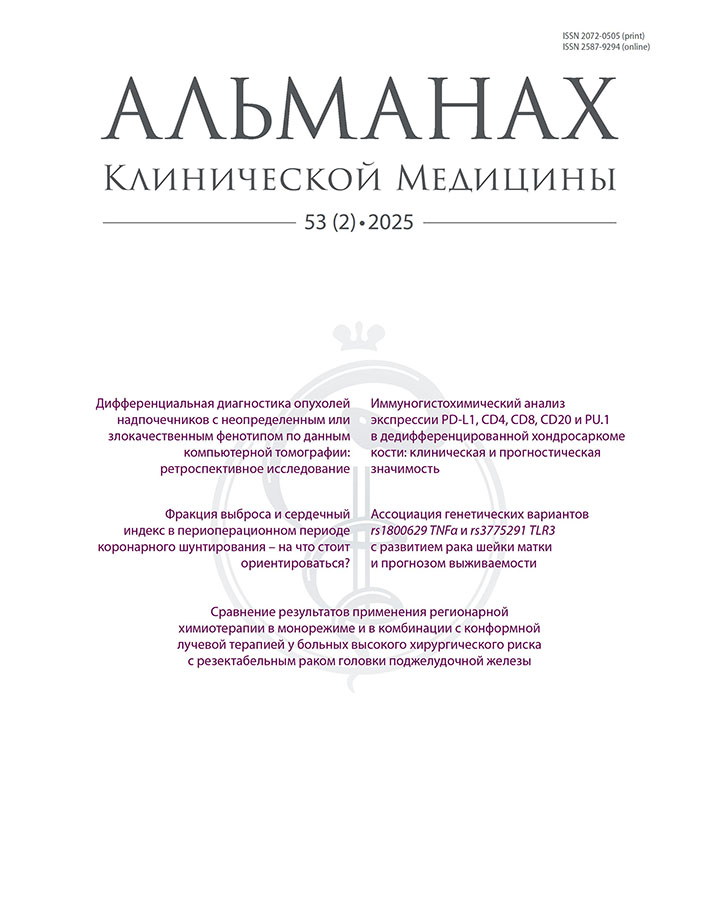ВОЗМОЖНОСТИ ОПРЕДЕЛЕНИЯ ЗРЕЛОСТИ ПЛОДА ПРИ УЛЬТРАЗВУКОВОЙ ДИАГНОСТИКЕ
- Авторы: Лысенко С.Н.1, Чечнева М.А.1, Петрухин В.А.1, Аксенов А.Н.1, Ермакова Л.Б.1
-
Учреждения:
- ГБУЗ МО «Московский областной научно-исследовательский институт акушерства и гинекологии»
- Выпуск: № 37 (2015)
- Страницы: 41-46
- Раздел: АКУШЕРСТВО
- URL: https://almclinmed.ru/jour/article/view/250
- DOI: https://doi.org/10.18786/2072-0505-2015-37-41-46
- ID: 250
Цитировать
Полный текст
Аннотация
Актуальность. Экстрагенитальные заболевания беременной, осложнения беременности зачастую диктуют необходимость досрочного родоразрешения, при этом состояние плода является одним из критериев, определяющим сроки родов и способ родоразрешения. В этой связи перед врачом стоит задача правильно оценить зрелость плода.
Цель – определить эхографические маркеры функциональной зрелости плода.
Материал и методы. Обследованы 120 беременных в сроки гестации от 35 до 40 недель. Кроме стандартной фетометрии оценивались межполушарный размер мозжечка, наибольший размер ядра Беклара, соотношение между корковым и мозговым веществом надпочечников плода (надпочечниковый коэффициент), соотношение между эхоплотностью легких, печени и мочи плода (по анализу гистограмм).
Результаты. До 36 недель гестации межполушарный размер мозжечка составлял менее 52 мм, начиная с 37 недель – более 53 мм, с 40 недель – 58 мм и более. Все новорожденные с антенатально установленным межполушарным размером мозжечка 53 мм и более оценены после рождения как зрелые (p < 0,05). Все новорожденные с антенатально установленной величиной ядра Беклара 5 мм и более оценены после рождения как зрелые (p < 0,05). В сроке 35–35,6 недели средние значения надпочечникового коэффициента во всех наблюдениях превышали 1. Начиная с полных 36 недель беременности этот показатель снижался до величины 0,94 и в дальнейшем прогрессивно уменьшался. Среди новорожденных с антенатальной оценкой надпочечникового коэффициента 0,99 и менее (p < 0,05) признаков функциональной незрелости или проявлений респираторного дистресса ни в одном наблюдении не выявлено. Соотношение эхоплотности легких и эхоплотности содержимого мочевого пузыря плода возрастает до 37 недель гестации и остается постоянным до 40 недель. Соотношение плотности печени при сравнении с тем же субстратом незначительно уменьшается за счет снижения эхоплотности самой печени. Показатель соотношения эхоплотности легкого и эхоплотности печени до 36 недель составлял не менее 1,41 и уменьшался в период с 37 до 40 недель беременности.
Заключение. Фетометрический показатель межполушарного размера мозжечка имеет максимальную корреляцию с гестационным сроком и может служить косвенным признаком функциональной зрелости плода. Показателями, наиболее четко отражающими зрелость тканей плода и позволяющими сформировать прогноз респираторного дистресса новорожденного, могут служить величина ядра Беклара и надпочечниковый коэффициент. Линейные размеры надпочечника не могут служить критерием зрелости, так как велика погрешность измерений, зависящая от уровня среза его высоты (пирамидальная форма). Несмотря на увеличение соотношения эхоплотности легкого и печени с увеличением срока гестации, оно не может считаться достоверным признаком зрелости легочной ткани после 35 недель беременности.
Об авторах
С. Н. Лысенко
ГБУЗ МО «Московский областной научно-исследовательский институт акушерства и гинекологии»
Email: fake@neicon.ru
канд. мед. наук, ст. науч. сотр. лаборатории перинатальной диагностики
РоссияМ. А. Чечнева
ГБУЗ МО «Московский областной научно-исследовательский институт акушерства и гинекологии»
Автор, ответственный за переписку.
Email: marina-chechneva@yandex.ru
д-р мед. наук, руководитель лаборатории перинатальной диагностики
РоссияВ. А. Петрухин
ГБУЗ МО «Московский областной научно-исследовательский институт акушерства и гинекологии»
Email: fake@neicon.ru
д-р мед. наук, профессор, руководитель акушерского физиологического отделения
РоссияА. Н. Аксенов
ГБУЗ МО «Московский областной научно-исследовательский институт акушерства и гинекологии»
Email: fake@neicon.ru
канд. мед. наук, руководитель отделения неонатологии
РоссияЛ. Б. Ермакова
ГБУЗ МО «Московский областной научно-исследовательский институт акушерства и гинекологии»
Email: fake@neicon.ru
аспирант лаборатории перинатальной диагностики
РоссияСписок литературы
- Ткаченко АК, Устинович АА, ред. Неонатология. Минск: Вышэйшая школа; 2009. 497 с. (Tkachenko AK, Ustinovich AA, editors. Neonatology. Minsk: Vysheyshaya shkola; 2009. 497 р. Russian).
- Шабалов НП. Неонатология. В 2 т. М.: МЕДпресс-информ; 2009. (Shabalov NP. Neonatology. Moscow: MEDpressinform; 2009. Russian).
- Ордынский ВФ, Макаров ОВ. Сахарный диабет и беременность. Пренатальная ультразвуковая диагностика. М.: Видар-М;
- 212 c. (Ordynskiy VF, Makarov OV. Diabetes mellitus and pregnancy. Prenatal ultrasound diagnosis. Moscow: Vidar-M; 2010. 212 p. Russian).
- Пальцев МА, Коваленко ВЛ, Аничков НМ. Руководство по биопсийно-секционному курсу. М.: Медицина; 2002. 256 с. (Pal'tsev MA, Kovalenko VL, Anichkov NM. A guidebook on biopsy and dissection. Moscow: Meditsina; 2002. 256 р. Russian).
- Агеева МИ, Воронина ТГ, Митьков ВВ. Нормальная эхографическая анатомия надпочечников плода. Ультразвуковая и функциональная диагностика. 2012;(6): 39–48. (Ageeva MI, Voronina TG, Mit'kov VV. [Normal echographic anatomy of fetal adrenal glands]. Ul'trazvukovaya i funktsional'naya diagnostika. 2012;(6):39–48. Russian).
- Милованов АП. Внутриутробное развитие человека. Руководство для врачей. М.: МДВ; 2006. 384 с. (Milovanov AP. Human intrauterine development. Textbook. Moscow: MDV; 2006. 384 p. Russian).
- Сидорова ИС. Физиология и патология родовой деятельности. М.: МИА; 2006. 240 с. (Sidorova IS. Physiology and pathophysiology of birth activity. Moscow: MIA; 2006. 240 р. Russian).
Дополнительные файлы








